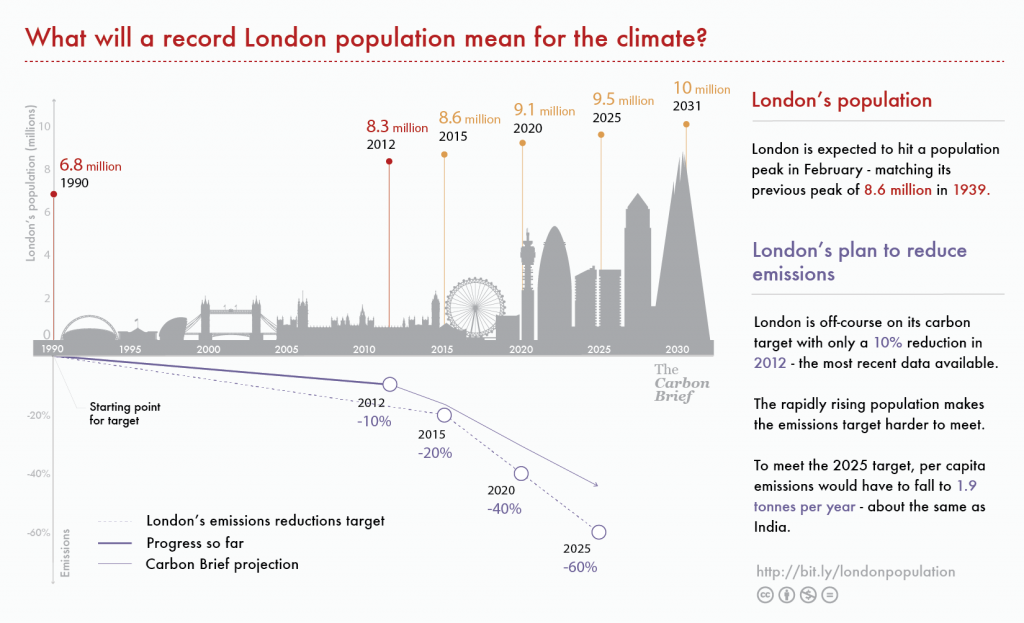
London set to miss mayor’s climate change targets as population booms
Simon Evans
01.09.15Simon Evans
09.01.2015 | 11:50amUpdate 9/2016 – Following the election of Sadiq Khan as London mayor, the Greater London Authority website has been cleared of policy documents relating to Boris Johnson’s years in charge. Some information relating to Johnson’s climate policies is still available via the Internet Archive. See for example a summary of the climate goals set under Johnson.
The UK’s capital is likely to miss ambitious climate targets set by mayor Boris Johnson, Carbon Brief analysis shows. With London’s population expected to reach an all-time high within weeks, already-challenging climate goals are becoming even harder to meet.
Greenhouse gas emissions from the capital were 10 per cent below 1990 levels in 2012, the most recent official London climate inventory data show. But that wasn’t on target – emissions were supposed to have fallen 14.5 per cent that year, according to the mayor’s climate plan.
This year emissions may be 17 per cent below 1990 levels, Carbon Brief projections suggest, assuming recent trends have continued. This would be more than one million tonnes short of the mayor’s interim goal for a 20 per cent reduction by 2015.
Back in 2011, Johnson announced that London would aim to cut its emissions 60 per cent by 2025, on 1990 levels. Carbon Brief projections suggest this target will be missed by a wide margin unless something changes, with London on track for just a 40 per cent cut.
London lags, not leads on climate
The mayor’s 2025 climate target and interim goals for 2015 and 2020 were set out in Delivering London’s Energy Future, his climate change mitigation and energy strategy. This explained how the targets would be met through action by the mayor’s office along with private initiatives and national government policies.
The 60 per cent London target was and remains more ambitious than that set for the UK as a whole, which is aiming for a 50 per cent reduction by 2023-27.
The mayor’s strategy said London should take a leadership role in tackling climate change. However, progress so far shows London lagging the UK as a whole. London’s had achieved a 10 per cent carbon reduction in 2012, significantly less than the rest of the UK which saw emissions 25 per cent below 1990 levels in the same year.
Part of the reason the capital is struggling to achieve its aims is faster than expected population growth. The mayor’s climate targets were set as part of his London Plan, including the assumption that London’s population would reach 8.8 million by 2031.

Credit: Rosamund Pearce/Carbon Brief using figures from the 2012 London Energy and Greenhouse Gas Inventory, Carbon Brief projections and Further Alterations to the London Plan.
In fact, London’s population has increased far more rapidly than expected. Updated projections published last year have London reaching 8.8 million by around 2017 – 14 years sooner – and 10 million by 2031. London’s population has already grown by a quarter since 1990, outstripping the rest of the UK, which has grown by around 10 per cent.
This makes meeting an overall carbon reduction target for all of London much more challenging. Potential Conservative mayoral candidate Michael Liebreich tells Carbon Brief:
Disappointing progress
Liebreich adds that progress so far is “definitely disappointing” and that London “must do more”, but that the mayor alone can only do so much.
Opinions on where responsibility lie differ. Prospective Labour mayoral candidate Christian Wolmar tells Carbon Brief:
The London Assembly environment committee said last year that the mayor “could do better” on climate and that important milestones were being missed. But this verdict was not backed by Conservative members, who said the mayor had made “groundbreaking” efforts.
A 2014 progress report from the mayor’s office also said progress against the 60 per cent carbon target “has been good”. Carbon Brief asked the mayor’s office if this target was still achievable, given the likelihood that interim goals would be missed. We had not received a response at time of publication, although a spokesperson tells Carbon Brief that London’s per capita emissions are the lowest for any UK region.
Londoners have lower carbon emissions
Indeed London, along with other major urban areas, has much lower per capita emissions than less densely populated areas of the UK. Londoners have nearly half the emissions of the average UK citizen.
Denser populations have lower emissions because of reduced reliance on cars for transport and smaller, more closely packed homes, analysis by the ENDS Report shows. The problem for London is that lower per-capita emissions don’t matter much when your population is growing so rapidly.
But London isn’t even doing that well in reducing per-capita emissions, relatively speaking. London’s per capita emissions were 4.9 tonnes in 2012 down from 6.6 tonnes in 1990, a 26 per cent reduction. But UK per capita emissions are falling faster, down by a third in the same time period, to 9.1 tonnes.
Climate leadership?
In order to meet the climate targets set by the mayor and given higher-than-expected population growth, London’s per capita emissions must fall to 1.9 tonnes in 2025, around the same as India’s today. If achieved, it would show the international climate leadership Boris Johnson called for in his 2011 climate strategy: where London leads, the UK and the rest of the world would have to follow. But it’s a huge challenge.
Main image: A view of the London skyline from the Millennium Bridge.
-
London set to miss mayor's climate change targets as population booms
-
London likely to miss ambitious climate targets set by mayor Boris Johnson, Carbon Brief analysis shows

